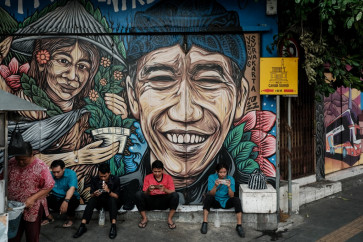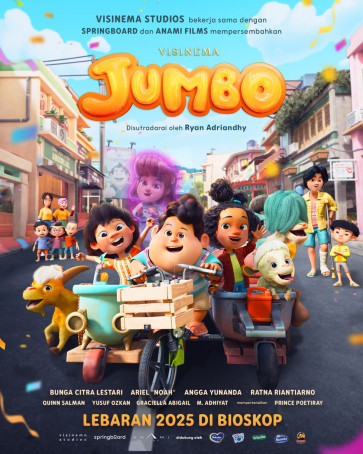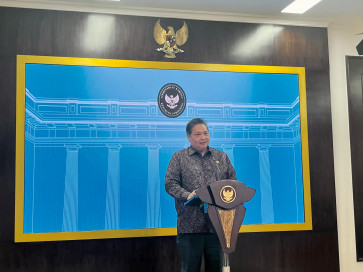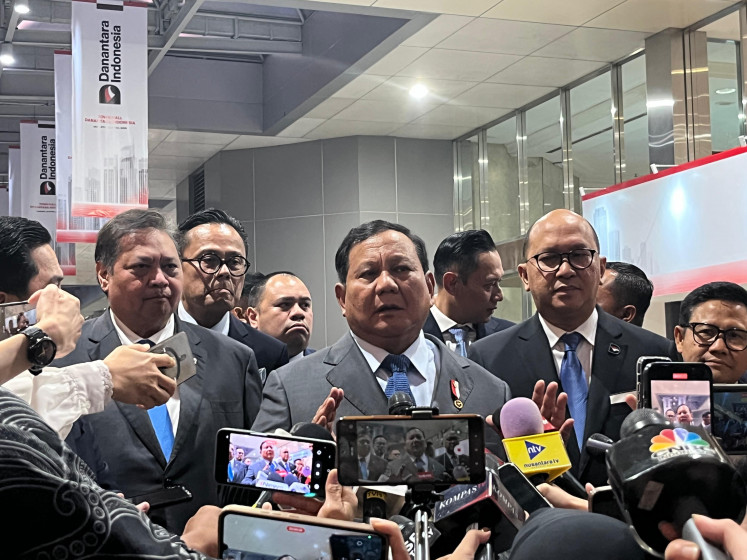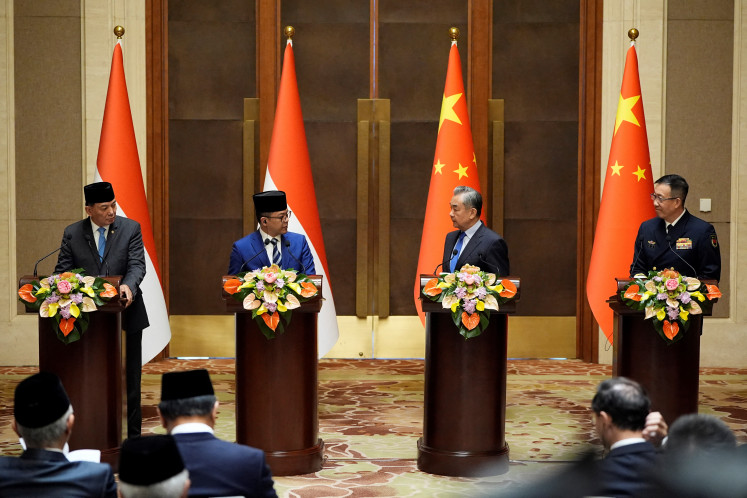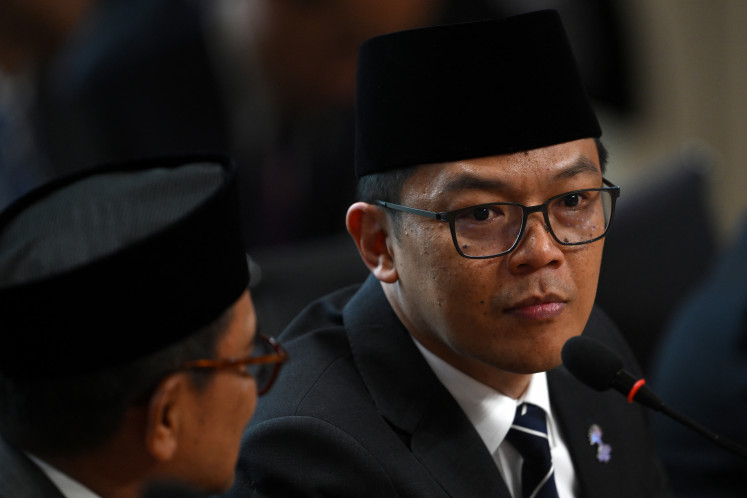Wander Lust: Finding serenity in South Sulawesi
WORDS STEFANI RIBKA PHOTOS BILLY SEPTIAN AND STEFANI RIBKAPassing through meadows with horses and cows grazing against the backdrop of hills with a turquoise sea in the horizon, we were heading to Cape Bira (Tanjung Bira), 200 kilometers, or a five hour drive, from Makassar, the capital of South Sulawesi province
Change text size
Gift Premium Articles
to Anyone

WORDS STEFANI RIBKA PHOTOS BILLY SEPTIAN AND STEFANI RIBKA
Passing through meadows with horses and cows grazing against the backdrop of hills with a turquoise sea in the horizon, we were heading to Cape Bira (Tanjung Bira), 200 kilometers, or a five hour drive, from Makassar, the capital of South Sulawesi province.
Those familiar with Makassar might want an experience other than the typical city tour, so my family and I decided to explore beyond the city to the natural sites in the surrounding areas.
Tanjung Bira was first on our list. The cape stretched into “U” shape at the tail of the province. It is formed by several beaches, such as the Bira and Bara beaches, boasting white sands and water so clear one could even see jellyfish swimming and beaming in the shallow parts.
A 20-minute drive from the beaches is Apparalang Cliff, a cliff that was given access recently. It displays a majestic view of the sea from the cliff. A stairway was made for visitors to reach the sea and swim when the tide is calm.
With more days to spend, one could continue on to the see the atolls at Taka Bone Rate National Park, but with no time we just enjoyed two days of unforgettable Bira.
The sites in Bulukumba regency, which has only 341 people living in each square kilometer, may be the perfect place for living as it is not crowded and not too quiet. Nature’s bounty also provides an income for the residents in the form of fishing, hotels or restaurants.
The beautiful area was not overexploited with only a short list of Lonely Planet-recommended backpacker hostels and luxury resorts and more choices for budget hotels and inns, all ranging from Rp 100,000 (US$7.6) to more than Rp 1 million.
One can rent a car or a motorbike as the hotels, shops and restaurants are quite the distance from each other, but there is still the option to stroll along the beach or enjoy a breath of fresh air while walking in the forest behind the beaches.
We stayed on a hill overlooking Bira Beach at a budget hotel owned by the locals who cooked us fresh seafood for lunch, which we ate on their wide bamboo bench just outside their kitchen while enjoying the views of the sea and hills.
Earlier in the morning, we woke up to the turquoise sea below the hill with birds chirping to start the day.
On the beach were some fisherfolk arriving from their night-long sailing trips. They immediately started selling some of their catch to the locals before sending the rest to the local market or saving a portion for their own daily meals.
Bira Beach, which is quieter on the weekdays, sees more visitors on weekends, leaving some spots with garbage. Cleaning staff of the regency come occasionally to clean up what is left behind, locals claim.
Nevertheless, the sea was clean enough for a swim. A few hundred meters from there is the more seldom visited Bara Beach, which may suit those looking for an even more tranquil ambience.
At 9 a.m. we took a speed boat 20 minutes out to sea to snorkel in front of Liukang Loe Island before we visited a turtle conservation. The boat ride costs Rp 300,000 to Rp 500,000 depending on the number of passengers and how you bargain.
The underwater view was simply amazing: world-class clean water with the raw ecosystem of colorful schools of fish and coral. You could spot some wild turtles and just enjoy the water for hours.
However, it is sad to know that the snorkeling activity in the area still uses traditional methods in which boat drivers throw anchors to the sea to steady the boat while visitors snorkel. Once pulled, the anchor will also pull coral up with it, which could significantly damage the ecosystem if this is allowed to happen long-term.
A good snorkeling center has one central jetty, from which visitors are picked up and dropped off by the boats to and from the snorkeling spots so that the boats stand by the jetty with ropes, not by the swimming spots with anchors.
On the shore, we did not find many souvenir shops, only a row of them at Bira Beach and an Indomaret in the surrounding village and a famous local warung (small restaurant), Bamboo, which we discovered at night with some young Caucasians learning Bahasa Indonesia with the locals.
Returning to Makassar from Bira, we passed some regencies, including Bulukumba, Jeneponto, Takalar and finally Gowa before arriving in the capital.
We tasted delicious seafood and the infamous mie titi (dried noodles served with thick vegetable soup) at Kampoeng Nelayan restaurant in Bulukumba, overlooking the bright sea bathed in sunlight in the afternoon.
Lots of stilt houses were seen on the way, as well as horse coto (meat stew in seasoned broth) restaurants, sea-salt farms in Jeneponto and watermelon stands in Takalar.
"Rammang-rammang"
Rammang-rammang, locally translated as clouds, is a small and peaceful village full of paddy fields surrounded by towering karsts in Maros and Pangkep regencies, 40 km or a one-and-a-half hour drive from Makassar.
The karst mountains, spanning 43,750 hectares in the two regencies, was nominated as a world heritage site by UNESCO in 2009 and is the second largest of its kind after South China Karst in Yunnan, China.
In this region there are hundreds of caves with stalactites and stalagmites, 89 of which are prehistoric, containing prehistoric rock art paintings, stone tools and kitchen waste consisting of shells from ancient Mollusca.
One can buy a tour package or take public transportation from the capital to stop at the Bosowa Cement intersection in Maros and walk down to a small dock heading to the village.
From there we enjoyed a 30-minute ride on a small wooden boat along the calm Pute River that felt like something out of the Avatar movie as the river, full of lush Nypah palm, was surrounded by karst. The two-way boat ride costs Rp 200,000 to Rp 300,000 depending on the number of passengers.
We were struck in awe as we arrived in the village with only 20 households — far apart from each other — supported by stilts above paddy farms and nearby fish ponds. If the neighbors needed something, they would just scream to each other from their stilt house veranda.
The Bugis-speaking locals did not speak too much Bahasa Indonesia as they lived on the income of farming, taking care of ducks and cows, driving boats or hosting travelers looking to spend nights gazing at the stars while experiencing the kampong life.
It felt like a different world being in Rammang-rammang. The karst acted as some kind of soundproof wall from the hustle and bustle of the city. All we heard were the swishing trees, endemic birds and cattle.
We enjoyed the interesting views while walking on the soil paths in between the paddy farms as we headed to King Kong cave, where we could see large stones forming a cave structure that resembled King Kong’s face.
Besides caves, there are three must-visit sites: Mata Air (water spring) in the village, karst forest and Telaga Bidadari (Angels Wells).
The climate in the Maros and Pangkep areas is tropical in the dry season from November to April. Meanwhile, the rainy season runs from May to October so it would be wise to bring rain coats.

